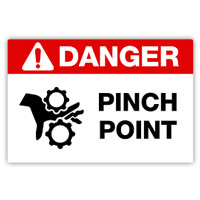June Safety Tip: Evading Pinch Point Hazards
Jun 04, 2019

Nearly all equipment you work with on the farm presents pinch point hazards. The most common sources of pinch point injuries in agribusiness are belt drives, chain drives and gear drives in power transmission devices. Feed rolls, gathering chains and other machinery designed to draw crops in are also responsible for many on-the-job pinch point accidents.
It is a common misconception that pinch injuries cannot be serious. In fact, they can be deadly, and are one of the most common types of workplace accidents. Body parts or loose clothing can be caught directly in pinch points, or the energy of the moving parts could cause you to be drawn into the pinch point. Either way, these hazards can often be prevented by engineering controls, personal protective equipment (PPE) and by using care, caution and alertness on the job.
To reduce your risk of pinch point injuries at work, consider the following safety recommendations.
- Before beginning your shift or when working with new equipment, identify potential pinch point hazards. Analyze objects that have the potential to move and ask yourself:
- “If this part moves, how will it affect me?”
- “Will my body be in the way of the movement?”
- Identify objects in the workplace that move and come in contact—or close contact—with fixed objects.
- Be extremely cautious when placing your hands, fingers or feet between two objects. If you are within a pinch point, consider alternative ways to get the task done. If there is no other way to complete the task, make sure that all moveable parts are immobilized before continuing to work.
- Do not operate machinery without the proper guarding equipment in place. If you need to perform repairs or adjustments to the guards themselves, replace them before using the machinery again.
- Never use your feet to brace, force or chock objects.
- Wear appropriate gloves for the task at hand. They will serve as protection against injuries, but ill-fitting gloves may be an additional hazard if they get caught in equipment.
- Follow all lockout/tagout procedures.
- Watch out for rolling hazards by blocking wheels on equipment and trucks to prevent unwanted movement.
- Watch out for crushing dangers—if you work under a truck or other machinery, make sure the jacks are secure.
- Refrain from wearing jewelry or loose clothing, and always tie long hair back. These items can get caught in moving parts.
- Know how to turn off equipment immediately in case of an emergency.